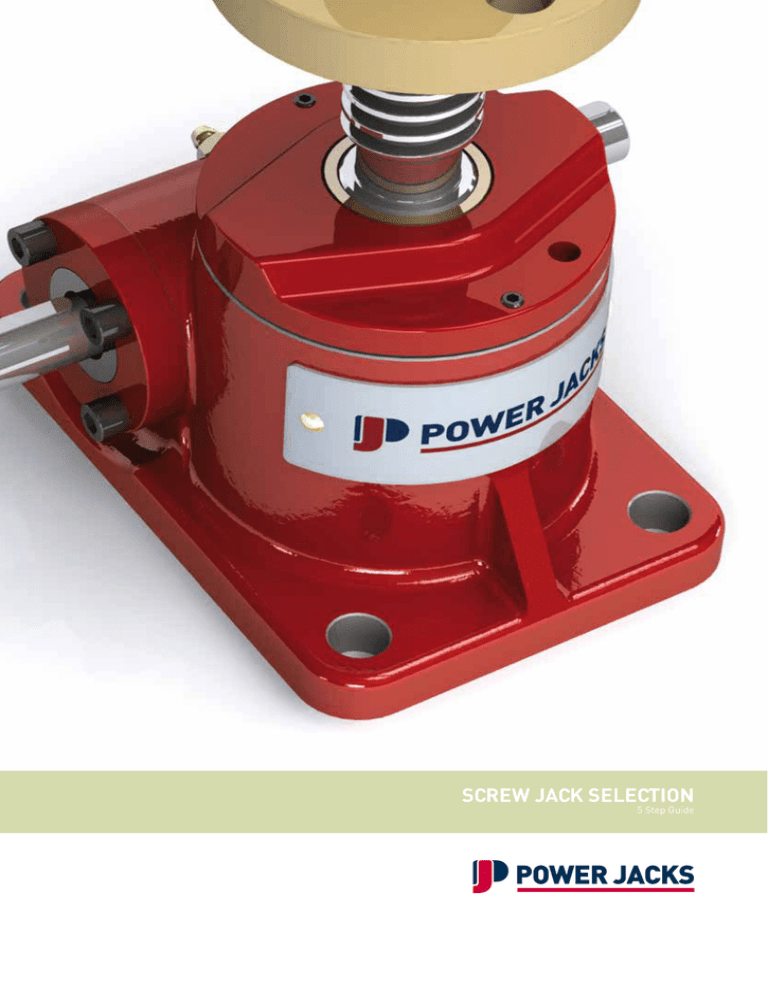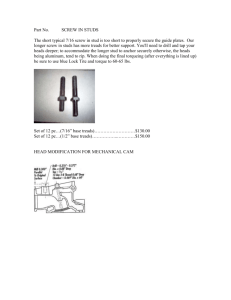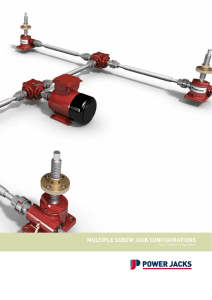
SCREW JACK SELECTION
5 Step Guide
Initial Screw Jack Selection
1.
Five Step Guide to Initial Screw Jack Selection
The following selection procedure is applicable for Machine and Ball Screw Jacks.
Calculate Power and Torque Requirements
Select a Screw Jack from the tables with adequate load carrying capacity and note the Screw jack static and dynamic
efficiency for required input speed.
Step 1 - Screw Jack Input Speed
N (rpm) =
Raise Rate (mm/min) *Gear Ratio
Pitch (mm) * N° of Starts on Lifting Screw
Note Screw Jack Input speed should not exceed
1800 rpm.
Step 2 - Operating Input Power (kW), Pin
Pin(kW) =
Load (kN) * Raise Rate (mm/min)
60000 * ηad
ηad = Dynamic Screw Jack Efficiency
Step 3 - Operating Input Torque
Tino (Nm) =
Pin (kW) * 9550
N (rpm)
Step 4 - Screw Jack Start-Up Torque
Tins =
Load (kN) * Pitch (mm) * N° of Starts on Lifting Screw
2 * π * ηas * Gear Ratio
ηas = Static Screw jack Efficiency
Step 5 - Mechanical Power and Torque Check
Check whether the Screw Jack power and torque required for the application is not greater than the maximum
allowable mechanical input power (Pmechanical) and Start-Up Torque at Full Load (Ts) values specified in the
Screw Jack performance tables.
If Pmechanical > Pin & Ts > Tins then the Screw Jack selected is acceptable for power requirements.
2
www.powerjacks.com
Example Intial Screw Jack Selection
2.
Example Selection
Application Constraints
•
•
Load on Screw Jack = 15 kN in Tension
Raise Rate required = 100 mm/min
Consider all application constraints then choose a Screw Jack that looks suitable for the application with a load rating equal
to or greater than the maximum working load. For this example say a 25 kN Sym-metric Screw Jack (refer 1.2.1.) with translating screw,
6:1 gear ratio, single start lifting screw (6 mm lead).
Calculate Power and Torque Requirements
Step 1 - Screw jack Input Speed
100 (mm/min) * 6 (Gear Ratio)
N (rpm) =
6 (mm) * 1 (N° of starts on Lifting Screw)
N = 100 rpm
Note Screw Jack Input Speed should not exceed
1800 rpm.
Step 2 - Operating Input Power (kW), Pin
15 (kN) * 100 (mm/min)
Pin(kW) =
60000 * 0.275
Pin = 0.091 kW
Step 3 - Operating Input Torque
Tino (Nm) =
0.091 (kW) * 9550
100 (rpm)
Tino = 8.7 Nm
Step 4 - Screw Jack Start-Up Torque
15 (kN) * 6 (mm) * 1 (N° of starts on Lifting Screw)
Tins =
2 * π * 0.208 * 6 (Gear Ratio)
Tins = 11.5 Nm
ηas = 0.208 (refer 1.2.1.1)
Step 5 - Mechanical Power and Torque Check
Find the Screw jacks mechanical power and torque rating from the performance data tables (refer 1.2.1.1.)
Pmechanical = 1.5 kW > Pin and Ts = 19 Nm > Tins
Therefore the Screw jack selected is suitable for application for initial constraints tested, further analysis may be required
to ensure the Screw Jack is suitable for all application conditions (refer 1.1.3.1. or consult Power Jacks Ltd).
www.powerjacks.com
3
Lifting & Positioning Solutions
Power Jacks are specialist industrial engineers providing design,
manufacturing and services of quality industrial lifting, positioning and
load monitoring equipment.
Our products are supplied globally across many sectors including
Industrial Automation, Energy, Transport, Defence and Civil.
Power Jacks Ltd
Balmacassie Commercial Park
Ellon, AB41 8BX
Scotland (UK)
Tel: +44 (0)1358 285100
www.powerjacks.com
sales@powerjacks.com
Sign up for News and Updates
PJSJDS-SEL-EN-02
FPAL
Registered
All information in this document is subject to change without notice. All rights reserved by Power Jacks Limited.
May not be copied in whole or in part. ©Power Jacks Limited 2014, Aberdeenshire, Scotland, United Kingdom.





